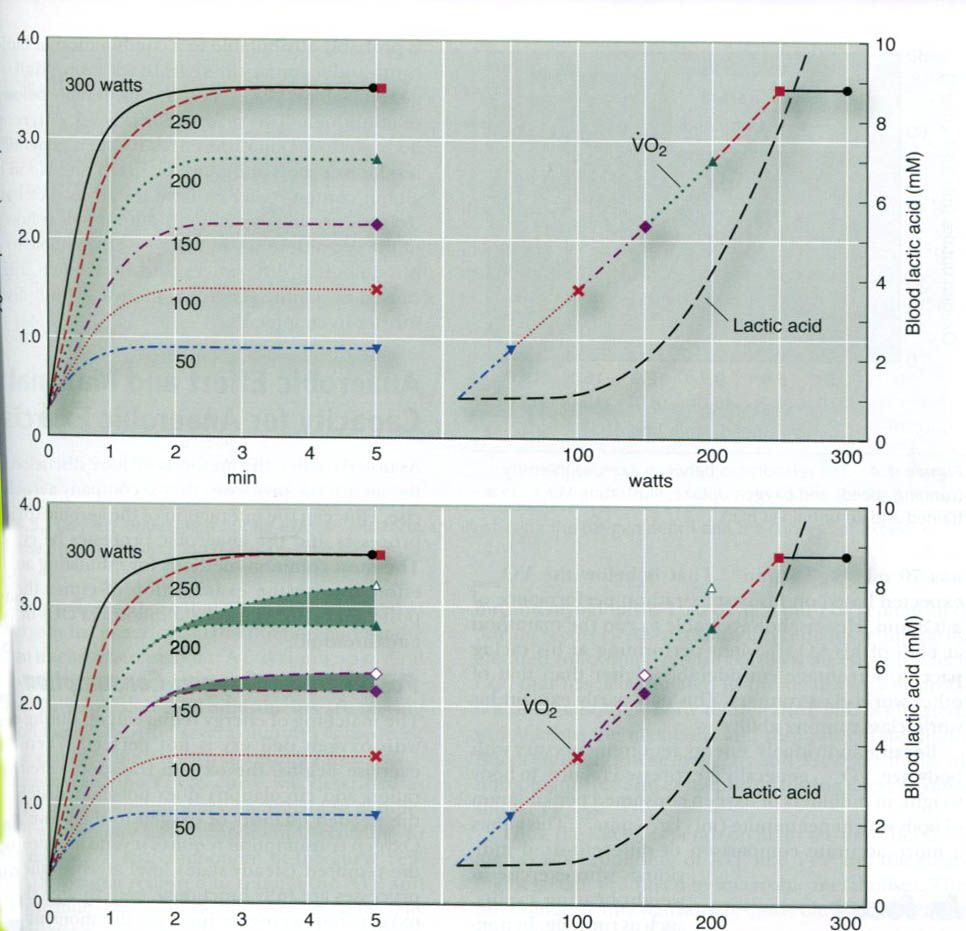In the figure shown, it is clear that when the
subject cycled at 300W, the VO2 response was not different from that achieved
at 250W. This indicates that the subject had reached a maximal limit of this
ability to increase his VO2. This peak value is referred to as
aerobic capacity, maximal oxygen uptake, or VO2max.
VO2max is regarded by most at the best single measurement of
cardiorespiratory endurance and aerobic fitness. This concept is further
illustrated in other figure below, which compares the VO2max of a
trained and untrained man.
Although some sport scientists have suggested
that VO2max is a good predictor of success in endurance events, the
winner of a marathon race cannot be predicted from the runner’s laboratory-measured
VO2max. Likewise, an endurance running performance test is only a
modest predictor of one’s VO2max. This suggests that a good
performance requires more than a high VO2max.
Also, research has documented that VO2max
increases with physical training for only 8 to 12 weeks and that this value
then plateaus despite continued higher-intensity training. Although VO2max
does not continue to increase, the participants continue to improve their
endurance performance. It appears that these individuals develop the ability to
perform at a higher percentage of their VO2max. Most runners, for
example, can complete a 42km marathon at an average pace that requires them to
use approximately 75% to 80% of their VO2max.
Consider the case of Alberto Salazar, a near
world record holder in the marathon. His measured VO2max was 70 ml x
kg-1 x min-1. That is below the VO2max
expected based on his best marathon performance of 2h 8min. He was, however,
able to run marathon on 86% of his VO2max when performing at his racing
pace, a percentage considerably higher than that of other world-class runners.
This may partly explain his world-class running ability.
Because individuals’ energy requirements vary
with body size, VO2max generally is expressed relative to body weight,
in milliliters of oxygen consumed per kilogram of body weight per minute(ml x
kg-1 x min-1). This allows a more accurate comparison of
different-sized individuals who exercise in weight-bearing events, such as
running. In non-weight-bearing activities, such as swimming and cycling,
endurance performance is more closely related to VO2max measured in liters per minute.
Normally active, but untrained,
18-to-22-year-old college students have average VO2max values of 38
to 42 ml x kg-1 x min-1 for women and 44 to 50 ml x kg-1
x min-1 for men. After the age of 25 to 30 years, inactive people VO2max
values decrease about 1% per year. This is probably attributable to a
combination of biological aging sedentary lifestyle. In addition, adult women
generally have VO2max values considerably below those of adult men.
Two reasons for this sex difference are body
composition differences(women generally have less fat-free mass and more fat mass) and blood hemoglobin content(women have less, thus they have less
oxygen-carrying capacity). But it is unclear how much of the sex difference in
VO2max is attributable to actual physiological differences and how
much might be caused by a more sedentary lifestyle.











0 коментара:
Постави коментар